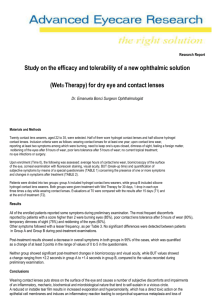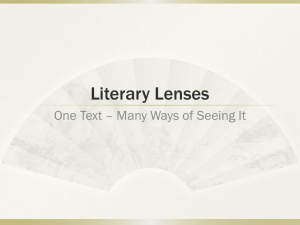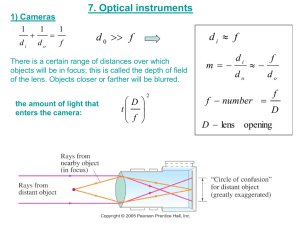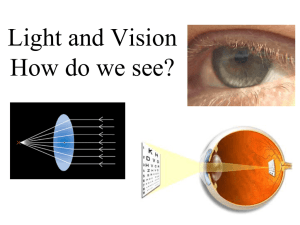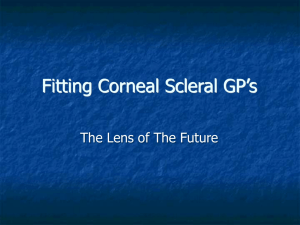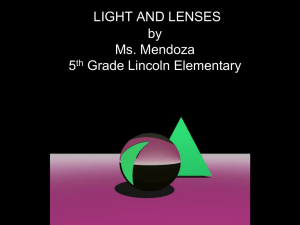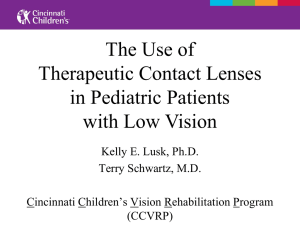Introduction to Contact Lenses
advertisement
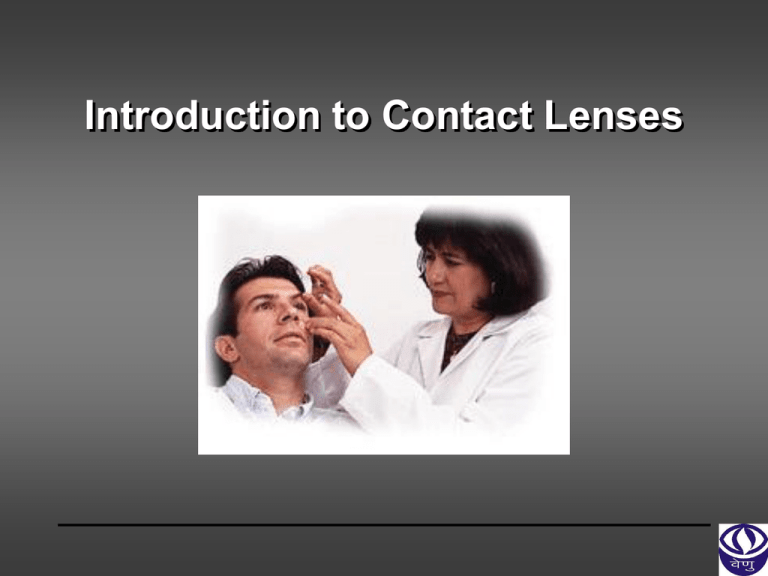
Introduction to Contact Lenses Objectives • • • • • Describe evolution of contact lenses Describe types of contact lenses Identify basic parameters of contact lenses Identify uses and benefits Describe fitting procedures and care regimens Contemporary History • Four significant milestones: 1940s – development of PMMA (hard lenses) 1970s – development of HEMA (“hydrogels” or soft lenses) 1980s – development of rigid gas permeable (RGP) lenses 1999 – development of silicone hydrogel lenses What is a Contact lens ? • Contact lens is an Optical device or lens which is used to correct Refractive errors, change color of the eye or for therapeutic purposes Types of Contact Lens: • Hard Contact lens - Obsolete as does not allow Oxygen to pass through • Rigid Gas Permeable lens (semi-soft lens)- allows better oxygen transmission.Poor comfort. Cumbersome fitting procedure • Soft Contact lens - allows good oxygen transmission. Highly comfortable. Easy to fit. Conventional Soft Lens Materials • • • • • • HEMA ( Hydroxy Ethyl Methacrylate) is the most common material for conventional lenses FDA has divided SCL materials into 4 groups on the basis of water content & Ionicity Group1- LWC,Non-Ionic Group2 –HWC,Non-Ionic Group 3- LWC, Ionic Group 4 –HWC, Ionic RGP Lens Materials • • • • • RGP lenses combine standard PMMA with silicone PMMA is a clear plastic material that is impermeable to oxygen Offer excellent vision Easy to handle, durable Simple to care for Silicone Hydrogel Lens Materials • Silicone and hydrogel are combined to create a revolutionary soft contact lens material • Exceptional oxygen permeability • Excellent on-eye performance and comfort Wear Modality • • Wear modality refers to how the contact lens if worn by the patient. Wear modality is divided into two groups: Daily wear Extended wear Continuous wear Replacement Schedule • • Replacement schedule refers to how often contact lenses are replaced Lenses are generally replaced on a “traditional schedule” or a planned replacement/disposable schedule “Traditional” Contact Lens Wear • • Patients once wore same pair of lenses until they experienced discomfort, or lens was lost or torn.Average life of a traditional lens is 1 year. Today, “traditional lens replacement” has been replaced with Planned Replacement/ Disposable schedules Planned Replacement/ Disposable (PRD) • • • Contact lenses are replaced more frequently (one to three months) Disposables are discarded at end of wear and never reused Disposable may be worn daily or extended wear basis Advantages of Contact lens over Spectacles: • Wider field of view (Improved Peripheral • • • • Vision) Active lifestyle No tell tale marks , no sliding down the nose No fogging wih sudden temperature changes Natural Good Looks Advantages of Contact lens over Spectacles: • Better clarity of Vision • Actual size of object is seen unlike in high power spectacles • IMMENSE SELF-CONFIDENCE See Better, Look Better, Feel Better Indications for Contact Lens Wear • Myopia • Hyperopia • • Astigmatism Presbyopia • Aphakia • Keratoconus • Astigmatism secondary to post-op/trauma • Corneal protection • Corneal healing • Occupational requirements Contraindications for Lens Wear • • • • • Anterior segment inflammation or infection Chronic ocular allergy Certain systemic diseases • • • • Ptosis Corneal hyposensitivity • Chronic dry eye Poor quality or inadequate tearfilm Occupational incompatibility Noncompliant, unmotivated patient Poor patient hygiene Contact Lens Design and Application Single Vision Spherical Soft Contact Lenses • • • • • Myopia Hyperopia Presbyopia Aphakia Most widely prescribed contact lenses Toric Soft Contact Lenses Presbyopic Soft Contact Lens Correction Cosmetic Tinted Soft Contact Lenses Therapeutic and Bandage Lenses • Promote corneal healing • Treat corneal/ocular disease • Collagen lenses offer good results Lens Care Systems • Deposits composed of protein, lipids, • mucin and other organic and inorganic substances need to be removed Cleaning Surfactant – to remove surface deposits Enzymatic – to remove protein deposits Lens Care Systems • Rinsing • Disinfection • Chemical disinfection Thermal disinfection Hydrogen peroxide Storage Lens Lubricants • • Lens lubricants are used when lenses become dry and uncomfortable Extended-wear lens patients are encouraged to use lubricants prior to sleep and upon waking For Further Queries Contact : Ms. Priyanka Singh Head – Optometry Service Email – optometry@venueyeinstitute.org End

